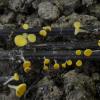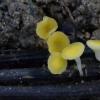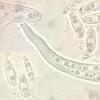
09-08-2017 19:24
Ethan CrensonDoes anyone have this?:Rogerson, C.T.; Samuels, G.

05-08-2017 18:54
 Bernard CLESSE
Bernard CLESSE
Bonsoir à tous,J'ai trouvé ce que je pense être

08-08-2017 17:12
This Peziza was on wet soil at the side of a mixed

12-02-2014 15:59
Eduard OsieckCan somebody provide me with the general key inclu

05-08-2017 21:46
 David Vaudoré
David Vaudoré
BonjourJ'ai trouvé ce petit asco en grand nombre
Hymenoscyphus
Andgelo Mombert,
06-08-2017 20:08
 Bonsoir à tous,
Bonsoir à tous,En ripisylve, sous Salix, sur support indéterminé. Pétiole ?
Spores 14-16 x 3-5,5 µm, guttulées, elliptiques parfois asymétriques, avec une extrémité plus obtuse que l'autre, septées à maturité.
Asques 90 x 8 µm, octosporées bisériées, à sommet amyloïde. Base sans crochets.
Paraphyses cylindriques, remplies de vacuoles réfringentes, 3,5 m de large.
Merci d'avance pour votre aide !
Andgelo
Hans-Otto Baral,
06-08-2017 21:12

Re : Hymenoscyphus
This is weird. It looks lke blackened petioles of a tree. You must look for the entire petiole, is it widened at the base, does it have scattered scars from lateral leaflets as in e.g. Fraxinus or not as in Acer?
Where is the yellow colour located, in oil droplets in the living paraphyses?
The spores look like Hymenoscyphus albidus on Fraxinus, but as the name says this is a white fungus.
Where is the yellow colour located, in oil droplets in the living paraphyses?
The spores look like Hymenoscyphus albidus on Fraxinus, but as the name says this is a white fungus.
Andgelo Mombert,
07-08-2017 19:21
Andgelo Mombert,
10-08-2017 19:21

Re : Hymenoscyphus
Dur d'émettre un avis sur ce probable pétiole.
Toujours rompu, les morceaux ne dépassent pas les 5 cm.
Pas de cicatrices... L'aspect très côtelé est gênant pour un pétiole ?
Et s'il s'agissait simplement de débris herbacés ???
Andgelo
Toujours rompu, les morceaux ne dépassent pas les 5 cm.
Pas de cicatrices... L'aspect très côtelé est gênant pour un pétiole ?
Et s'il s'agissait simplement de débris herbacés ???
Andgelo
Hans-Otto Baral,
10-08-2017 23:38

Re : Hymenoscyphus
I think petioles have usually an upper and lower side, i.e., when you make a cross section it is not radial symmetrical.
An entirely blackened herbaceous stem would be exceptional.
An entirely blackened herbaceous stem would be exceptional.




